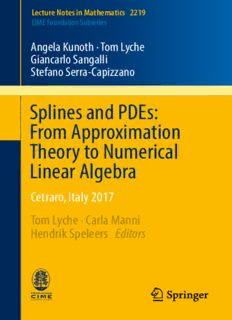Table Of ContentLecture Notes in Mathematics 2219
CIME Foundation Subseries
Angela Kunoth · Tom Lyche
Giancarlo Sangalli
Stefano Serra-Capizzano
Splines and PDEs:
From Approximation
Theory to Numerical
Linear Algebra
Cetraro, Italy 2017
Tom Lyche · Carla Manni
Hendrik Speleers Editors
Lecture Notes in Mathematics 2219
Editors-in-Chief:
Jean-MichelMorel,Cachan
BernardTeissier,Paris
AdvisoryBoard:
MichelBrion,Grenoble
CamilloDeLellis,Princeton
AlessioFigalli,Zurich
DavarKhoshnevisan,SaltLakeCity
IoannisKontoyiannis,Athens
GáborLugosi,Barcelona
MarkPodolskij,Aarhus
SylviaSerfaty,NewYork
AnnaWienhard,Heidelberg
Moreinformationaboutthisseriesathttp://www.springer.com/series/304
Angela Kunoth (cid:129) Tom Lyche (cid:129) Giancarlo Sangalli (cid:129)
Stefano Serra-Capizzano
Splines and PDEs:
From Approximation
Theory to Numerical
Linear Algebra
Cetraro, Italy 2017
Tom Lyche, Carla Manni, Hendrik Speleers
Editors
123
Authors
AngelaKunoth TomLyche
MathematicalInstitute DepartmentofMathematics
UniversityofCologne UniversityofOslo
Cologne,Germany Oslo,Norway
GiancarloSangalli StefanoSerra-Capizzano
DepartmentofMathematics DepartmentofScienceandHigh
UniversityofPavia Technology
Pavia,Italy UniversityofInsubria
Como,Italy
Editors
TomLyche CarlaManni
DepartmentofMathematics DepartmentofMathematics
UniversityofOslo UniversityofRomeTorVergata
Oslo,Norway Rome,Italy
HendrikSpeleers
DepartmentofMathematics
UniversityofRomeTorVergata
Rome,Italy
ISSN0075-8434 ISSN1617-9692 (electronic)
LectureNotesinMathematics
C.I.M.E.FoundationSubseries
ISBN978-3-319-94910-9 ISBN978-3-319-94911-6 (eBook)
https://doi.org/10.1007/978-3-319-94911-6
LibraryofCongressControlNumber:2018954553
MathematicsSubjectClassification(2010):Primary:65-XX;Secondary:65Dxx,65Fxx,65Nxx
©SpringerNatureSwitzerlandAG2018
Thisworkissubjecttocopyright.AllrightsarereservedbythePublisher,whetherthewholeorpartof
thematerialisconcerned,specificallytherightsoftranslation,reprinting,reuseofillustrations,recitation,
broadcasting,reproductiononmicrofilmsorinanyotherphysicalway,andtransmissionorinformation
storageandretrieval,electronicadaptation,computersoftware,orbysimilarordissimilarmethodology
nowknownorhereafterdeveloped.
Theuseofgeneraldescriptivenames,registerednames,trademarks,servicemarks,etc.inthispublication
doesnotimply,evenintheabsenceofaspecificstatement,thatsuchnamesareexemptfromtherelevant
protectivelawsandregulationsandthereforefreeforgeneraluse.
Thepublisher,theauthors,andtheeditorsaresafetoassumethattheadviceandinformationinthisbook
arebelievedtobetrueandaccurateatthedateofpublication.Neitherthepublishernortheauthorsor
theeditorsgiveawarranty,expressorimplied,withrespecttothematerialcontainedhereinorforany
errorsoromissionsthatmayhavebeenmade.Thepublisherremainsneutralwithregardtojurisdictional
claimsinpublishedmapsandinstitutionalaffiliations.
ThisSpringerimprintispublishedbytheregisteredcompanySpringerNatureSwitzerlandAG
Theregisteredcompanyaddressis:Gewerbestrasse11,6330Cham,Switzerland
Preface
Thefourchaptersofthisbookcollectthemaintopicsthathavebeenlecturedatthe
C.I.M.E.summerschool“SplinesandPDEs:RecentAdvancesfromApproximation
Theoryto StructuredNumerical Linear Algebra” held in Cetraro, July 2–7, 2017.
Theaimofthesummerschoolhasbeentogiveanintroductiontothemostadvanced
mathematical developments and numerical methods originating in the numerical
treatmentofPDEsbasedonsplinefunctions.
Arenewedinterestinsplinemethodshasbeenstimulatedinthelastdecadebythe
success of isogeometric analysis. The large research activity around isogeometric
methods shows that splines yield a powerful tool to PDE discretizations. In this
generalperspective,the progressofisogeometricanalysiswenthandin handwith
theformulationofnewproblemsrequiringnewtechniquestoaddressthemproperly.
This gave rise to novel (spline) results in different areas of classical numerical
analysis,rangingfromapproximationtheorytostructurednumericallinearalgebra.
Thesedevelopmentsmotivatedthetopicsofthesummerschool.
Thefirstchapter“FoundationsofSplineTheory:B-Splines,SplineApproxima-
tion, and Hierarchical Refinement” is written by us. It provides a comprehensive
and self-contained introduction to B-splines and their properties, discusses the
approximation power of spline spaces, and gives a review on hierarchical spline
bases.
Thesecondchapter“AdaptiveMultiscaleMethodsfortheNumericalTreatment
ofSystemsofPDEs”byAngelaKunothisdevotedtonumericalschemesbasedon
B-splines and B-spline-typewavelets as a particularmultiresolutiondiscretization
methodology,inthecontextofcontrolproblems.
The third chapter “Generalized Locally Toeplitz Sequences: A Spectral Anal-
ysis Tool for Discretized Differential Equations” by Carlo Garoni and Stefano
Serra-Capizzano presents the theory of generalized locally Toeplitz sequences, a
frameworkforcomputingandanalyzingthespectraldistributionofmatricesarising
fromthenumericaldiscretizationofdifferentialequations.
The last chapter “Isogeometric Analysis: Mathematical and Implementational
Aspects,withApplications”byThomasJ.R.Hughes,GiancarloSangalli,andMattia
Taniprovidesanoverviewofthemathematicalpropertiesofisogeometricanalysis,
v
vi Preface
discusses computationally efficient isogeometric algorithms, and presents some
isogeometricbenchmarkapplications.
We express our deepestgratitude to all the people who have contributedto the
success of this C.I.M.E. summer school: the invited lecturers, the seminar and
contributed talk speakers, and the authors who have contributed to this C.I.M.E.
Foundation Subseries book. In addition, we thank all the participants, from 11
countries,thatenthusiasticallycontributedtothesuccessoftheschool.Lastbutnot
least, we also thankC.I.M.E., in particular Elvira Mascolo (the C.I.M.E. director)
andPaoloSalani(theC.I.M.E.scientificsecretary)fortheir continuoussupportin
theorganizationoftheschool.
Oslo,Norway TomLyche
Rome,Italy CarlaManni
Rome,Italy HendrikSpeleers
Acknowledgments
ThisC.I.M.E.activitywascarriedoutwiththecollaborationandfinancialsupportof
INdAM(IstitutoNazionalediAltaMatematica)andEMS(EuropeanMathematical
Society). It was also partially supported by the MIUR “Futuro in Ricerca 2013”
Programmethroughtheproject“DREAMS.”
vii
Contents
1 FoundationsofSplineTheory:B-Splines,SplineApproximation,
andHierarchicalRefinement............................................... 1
TomLyche,CarlaManni,andHendrikSpeleers
2 AdaptiveMultiscaleMethodsfortheNumericalTreatmentof
SystemsofPDEs.............................................................. 77
AngelaKunoth
3 GeneralizedLocallyToeplitzSequences:ASpectralAnalysis
ToolforDiscretizedDifferentialEquations............................... 161
CarloGaroniandStefanoSerra-Capizzano
4 IsogeometricAnalysis:MathematicalandImplementational
Aspects,withApplications.................................................. 237
ThomasJ.R.Hughes,GiancarloSangalli,andMattiaTani
ix
Chapter 1
Foundations of Spline Theory: B-Splines,
Spline Approximation, and Hierarchical
Refinement
TomLyche,CarlaManni,andHendrikSpeleers
Abstract Thischapterpresentsanoverviewofpolynomialsplinetheory,withspe-
cialemphasisontheB-splinerepresentation,splineapproximationproperties,and
hierarchicalspline refinement. We start with the definition of B-splines by means
of a recurrence relation, and derive several of their most important properties. In
particular,weanalyzethepiecewisepolynomialspacetheyspan.Then,wepresent
the construction of a suitable spline quasi-interpolant based on local integrals, in
order to show how well any function and its derivatives can be approximated in
a given spline space. Finally, we provide a unified treatment of recent results on
hierarchical splines. We especially focus on the so-called truncated hierarchical
B-splines and their main properties. Our presentation is mainly confined to the
univariate spline setting, but we also briefly address the multivariate setting via
the tensor-product construction and the multivariate extension of the hierarchical
approach.
1.1 Introduction
Splines,inthebroadsenseoftheterm,arefunctionsconsistingofpiecesofsmooth
functionsgluedtogetherinacertainsmoothway.Besidestheirtheoreticalinterest,
they have application in several branches of the sciences including geometric
modeling,signalprocessing,dataanalysis,visualization,numericalsimulation,and
probability,just to mentiona few. There is a large variety of spline species, often
referredtoasthezooofsplines.Themostpopularspeciesistheonewherethepieces
arealgebraicpolynomialsandinter-smoothnessisimposedbymeansofequalityof
T.Lyche
DepartmentofMathematics,UniversityofOslo,Oslo,Norway
e-mail:[email protected]
C.Manni·H.Speleers((cid:2))
DepartmentofMathematics,UniversityofRomeTorVergata,Rome,Italy
e-mail:[email protected];[email protected]
©SpringerNatureSwitzerlandAG2018 1
T.Lycheetal.(eds.),SplinesandPDEs:FromApproximationTheorytoNumerical
LinearAlgebra,LectureNotesinMathematics2219,
https://doi.org/10.1007/978-3-319-94911-6_1
Description:This book takes readers on a multi-perspective tour through state-of-the-art mathematical developments related to the numerical treatment of PDEs based on splines, and in particular isogeometric methods. A wide variety of research topics are covered, ranging from approximation theory to structured n

